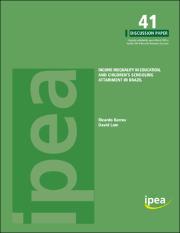Please use this identifier to cite or link to this item:
https://repositorio.ipea.gov.br/handle/11058/4850Full metadata record
| DC Field | Value | Language |
|---|---|---|
| dc.contributor.author | Barros, Ricardo Paes de | - |
| dc.contributor.author | Lam, David | - |
| dc.contributor.other | Macedo, Roberto (Comentários) | - |
| dc.coverage.spatial | São Paulo | pt_BR |
| dc.coverage.spatial | Nordeste | pt_BR |
| dc.coverage.spatial | Brasil | pt_BR |
| dc.coverage.temporal | 1982 | pt_BR |
| dc.date.accessioned | 2015-10-16T20:55:09Z | - |
| dc.date.available | 2015-10-16T20:55:09Z | - |
| dc.date.issued | 2015-01 | - |
| dc.identifier.uri | http://repositorio.ipea.gov.br/handle/11058/4850 | - |
| dc.description.abstract | O texto analisa os determinantes de escolaridade, em nível de domicílio, para crianças de 14 anos nas regiões urbanas de São Paulo e do Nordeste do Brasil, usando os dados da PNAD de 1982. Compara a escolaridade e a renda dos pais em São Paulo e no Nordeste, e encontra diferenças regionais nas características dos pais que são consistentes com as diferenças regionais dos resultados escolares das crianças. O estudo conclui que o aumento de escolaridade não responderá a melhorias no status sócio-econômico do domicílio em si. Os resultados sugerem que maior quantidade e melhor qualidade na oferta de ensino podem eliminar uma grande fração da diferença de escolaridade entre as regiões, mesmo na ausência de mudanças substanciais no status sócio-econômico dos pais. | pt_BR |
| dc.language.iso | en-US | pt_BR |
| dc.publisher | Instituto de Pesquisa Econômica Aplicada (Ipea) | pt_BR |
| dc.title | Income inequality in education, and children's schooling attainment in Brazil | pt_BR |
| dc.title.alternative | Discussion Paper 41 : Income inequality in education, and children's schooling attainment in Brazil | pt_BR |
| dc.title.alternative | A desigualdade de renda na educação e a realização da escolarização das crianças no Brasil | pt_BR |
| dc.type | Discussion Paper | pt_BR |
| dc.rights.holder | Instituto de Pesquisa Econômica Aplicada (Ipea) | pt_BR |
| dc.source.urlsource | http://www.ipea.gov.br | pt_BR |
| dc.location.country | BR | pt_BR |
| dc.description.physical | 35 p. : il. | pt_BR |
| dc.subject.vcipea | IPEA::Educação. Treinamento::Desenvolvimento da Educação. Política Educacional | pt_BR |
| dc.subject.vcipea | IPEA::Política Econômica. Política Social. Planejamento::Política Social | pt_BR |
| dc.rights.license | Reproduction of this text and the data it contains is allowed as long as the source is cited. Reproductions for commercial purposes are prohibited | pt_BR |
| dc.subject.keyword | Escolaridade | pt_BR |
| dc.subject.keyword | Desempenho escolar | pt_BR |
| dc.subject.keyword | Diferenças de Renda | pt_BR |
| dc.subject.keyword | Diferença de escolaridade entre as regiões | pt_BR |
| dc.relation.references | http://repositorio.ipea.gov.br/handle/11058/1898 | pt_BR |
| ipea.description.objective | Analisar os determinantes de desempenho escolar, em nível familiar, dos jovens de 14 anos, nas regiões urbanas de São Paulo e do Nordeste brasileiro, utilizando dados provenientes do PNAD - 1982. | pt_BR |
| ipea.description.additionalinformation | Série monográfica: Discussion Paper ; 41 | pt_BR |
| ipea.description.additionalinformation | Possui referências bibliográficas | pt_BR |
| ipea.description.additionalinformation | Série: Originally published by Ipea in March 1993 as number 294 of the series Texto para Discussão | pt_BR |
| ipea.access.type | Acesso Aberto | pt_BR |
| ipea.rights.type | Licença Comum | pt_BR |
| ipea.englishdescription.abstract | This paper analyzes the determinants of schooling attainment at the household level for 14-year-olds in urban regions of São Paulo and Northeast Brazil, using data from the 1982 PNAD. We find mean schooling of 4.75 years in São Paulo, and 3.25 years in the Northeast, both far short of the seven years of schooling that should have been completed by 14-years-olds. In attempting to explain the 1.5 year advantage in the schooling attainment of 14-year-olds in São Paulo, we find regional differences in the characteristics of parents that are consistent with the regional difference in child outcomes. Parents’ schooling and income are considerably higher in São Paulo, and inequality in parental schooling is higher in the Northeast. Regression estimates imply substantial positive effects of parental schooling and income on child schooling attainment. Our results suggest that only a small proportion of the gap in schooling attainment between São Paulo and the Northeast can be explained by differences in parental characteristics, however. Using our regression coefficients and mean characteristics in each region to predict schooling attainment off 14-year-olds, we are able to explain less than 20 percent of the 1.5 year schooling gap between the Northeast and São Paulo. This suggest that child schooling attainment will be relatively unresponsive to improvements in the socioeconomic status of household per se. The results suggest that direct increases in the quantity and quality of schooling supplied may be able to eliminate a large fraction of the schooling gap between regions, even in the absence of substantial changes in the socioeconomic status of parents. | pt_BR |
| ipea.researchfields | N/A | pt_BR |
| ipea.classification | Educação | pt_BR |
| Appears in Collections: | Educação: Livros | |
Files in This Item:
| File | Description | Size | Format | |
|---|---|---|---|---|
| DiscussionPaper_41.pdf | 1.09 MB | Adobe PDF |  View/Open |
Items in DSpace are protected by copyright, with all rights reserved, unless otherwise indicated.

